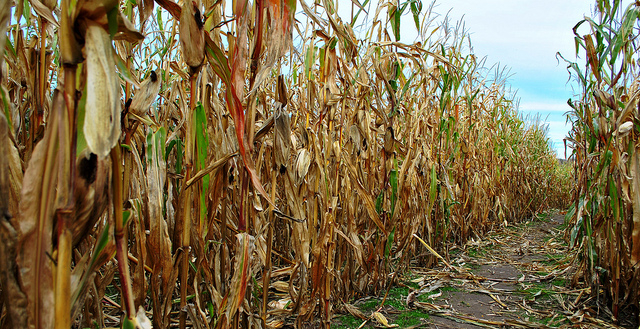I’ve been thinking lately about monoculture. It’s a term that’s familiar to those interested in food and agriculture and typically refers to the reliance on vast plantings of a single crop, such as corn or soy.
But monoculture isn’t just about what you plant. It’s also about how you plant and what you use to keep your plants alive. And while we can all share the goal of turning Big Ag into Better Ag, as the Natural Resources Defense Council’s Sasha Lyutse put it, many of the obstacles aren’t purely economic or scientific, they’re cultural.
Take the Marsden Farm Study that Mark Bittman has brought to national attention as a potential model for future farmers. In it, a team of U.S. Department of Agriculture and Iowa State University researchers embarked on a 10-year study that compared conventional “two-year” rotations of corn and soy (the dominant form of commodity growing) with three- and four-year rotations that mixed in other grains, alfalfa, and — in the case of the four-year rotation — livestock to provide manure fertilizer. As Bittman observed:
The results were stunning: The longer rotations produced better yields of both corn and soy, reduced the need for nitrogen fertilizer and herbicides by up to 88 percent, reduced the amounts of toxins in groundwater 200-fold and didn’t reduce profits by a single cent.
It smacks of the agricultural Holy Grail. Hold productivity and profits steady (the be-all and end-all for industrial ag proponents) but radically reduce fertilizer use (and thus runoff) as well as groundwater contamination. Suddenly, attacking the huge problem of oceanic dead zones and contaminated water supplies seem doable.
Even better, the rotations foil superweeds and superbugs by arresting the biological phenomena that give rise to resistant species, and thus offer farmers the option to jump off the chemical treadmill.
But Bittman’s conclusion that this “simple fix,” as he calls it in the article’s title, requires “no sacrifice, except to that of the bottom line of chemical companies” might not adequately capture the complexity of the context in which most Americans are farming.
In fact, he overlooks the vicious circle caused by the increase in corn production over the past several decades. It was the vast over-production of corn — far more corn than we could actually use — that helped fuel the rise of massive livestock feedlots. Today around 30 percent of the U.S. corn crop is fed to animals. Those billions of cattle, hogs, and chickens represent a lot of mouths to feed.
I point this out because the three- and four-year rotations used in the Marsden study would result in a much smaller annual corn and soy harvest. Just look at what the current drought, which caused a significant reduction in the size of the U.S. corn and soy harvest, has done to prices. The researchers both acknowledge and downplay this result when they observe that:
Although maize is grown less frequently in the 3-yr and 4-yr rotations than in the 2-yr rotation, this will not compromise the ability of such systems to contribute to the global food supply, given the relatively low contribution of maize and soybean production to direct human consumption and the ability of livestock to consume small grains and forages.
Fair enough. But, um, guys, you forgot about ethanol. Right now that’s the end product for around 40 percent of the U.S. corn crop. Indeed the jump in corn production decades ago happened at the same time as political and technological developments resulted in the Great Ethanol Boondoggle — huge government subsidies that redirect a significant portion of the American corn harvest into fuel tanks.
In fact, some farm state politicians will admit off-the-record that if not for ethanol, radical reforms to agricultural subsidies along the lines of the ones sustainable ag advocates support would have been on the table during the farm crisis of the 1980s. Ethanol didn’t arrive in time to stop the farm crisis then — but it helped provide a floor to the crash and has since kept corn prices on an upward trajectory. So it’s not surprising that the temptation to plant corn is probably almost unbearable for most Midwestern commodity farmers.
There’s another angle to this story that doesn’t get a lot of attention. It’s encapsulated by a single statistic: The average age of the American farmer is 57. Average. Your typical farmer is already close to retirement. This is not usually the point in your career when you throw out everything you’ve been doing for the last couple decades and adopt new habits.
And these multi-year rotations aren’t simple. As Bittman put it:
Perhaps most difficult to quantify is that this kind of farming — more thoughtful and less reflexive — requires more walking of the fields, more observations, more applications of fertilizer and chemicals if, when and where they’re needed, rather than on an all-inclusive schedule. “You substitute producer knowledge for blindly using inputs,” [study co-author Adam] Davis says.
I’m no fan of Monsanto, but for all the technological complexity behind its genetically modified seeds, the rotations and the chemical no-till techniques involved are far simpler than what Bittman is talking about. GMO seeds may have offered no real benefit to consumers, but they have made farmers’ lives a whole helluva lot simpler.
So this “simple” fix for farming is also paradoxically complex. What follows is a generalization, but if you’re a 62-year-old Iowa corn farmer and you look at what kind of changes you’d need to adopt to make these multi-year rotations work, you’ll probably just take a pass.
Sure, the government could step in and revamp farm subsidies. Indeed back when the Obama administration still acknowledged the existence of climate change, USDA Secretary Tom Vilsack talked about how farmers could value and be compensated for performing “ecological services,” or improvements in water, air, and soil quality.
It’s exactly this aspect of agriculture that the Marsden study explores. The problem is that being just as profitable as current farming isn’t good enough. There are intangible costs — and being set in one’s ways is only one of them. Matching the extensive, existing support structure of sales representatives, agricultural consultants, and extension agents involved in the current system is another.
In the past I’ve thought that perhaps climate and resource limits would force farmers’ hands sooner rather than later. And while climate may yet — corn country is moving north, forcing farmers in southern Plains states to diversify to other crops — resource restrictions may not. And the natural gas boom will ensure that synthetic fertilizer and other chemicals remain affordable for the foreseeable future.
Superweeds and superbugs may be the likeliest candidates for demanding farmers consider multi-year rotations. But Monsanto and Syngenta have their own chemical answers to those problems — and with them the promise of “business as usual” for farmers. It may be a Faustian bargain, but it’s still a bargain.
My view is that changing farming will require a “network effect.” A few pioneering farmers in various parts of the nation’s breadbasket will have to show the way for others. But that raises the question: Who will be farming all this Midwestern land in 10 years’ time? Farm prices are still at record highs; many farmers are old and getting older. Those who sell out will likely sell to bigger operations looking to expand — buyers who aren’t exactly prone to a “walking of the fields.”
As much as I hate to admit it, the forces arrayed in favor of the status quo are powerful, perhaps overwhelmingly so. But the impetus for changing farming will come from somewhere. The question is, will farmers choose to make the change themselves or instead have the change imposed on them by forces — climatic, biological, or financial — beyond their control?




